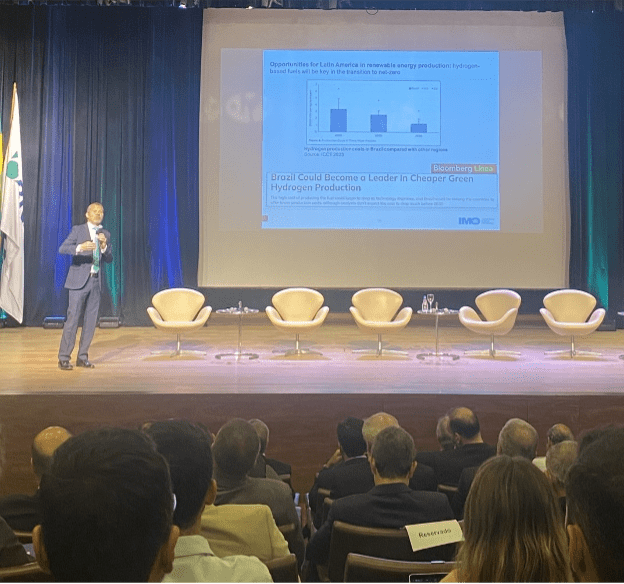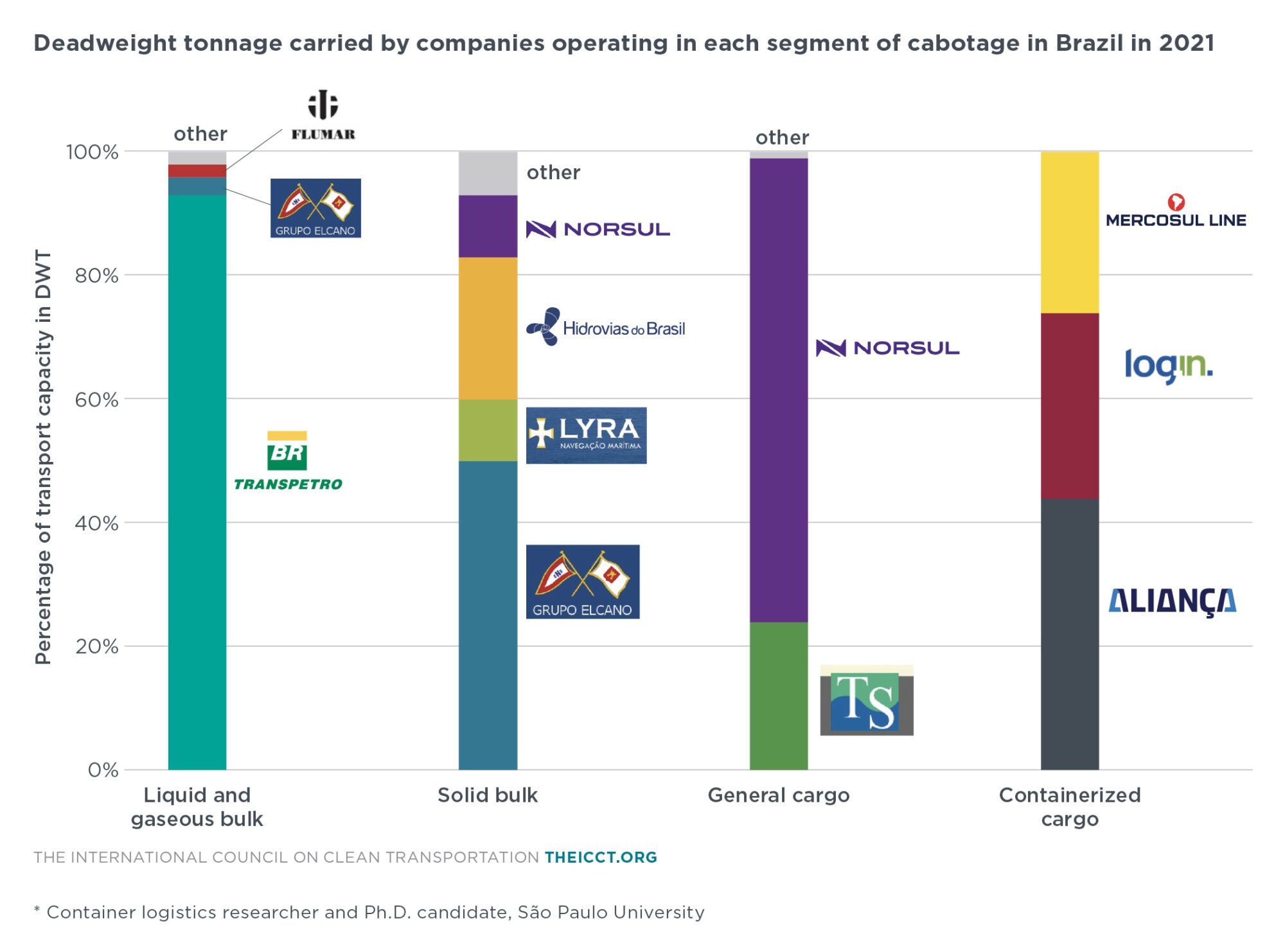Brasil traza el rumbo para un futuro marítimo limpio con un seminario fundamental
Blog
Brazil charts a course for a clean maritime future with a pivotal seminar
The Energy Transition in the Sea seminar held in Rio de Janeiro in late April marked a major step forward in plans to decarbonize Brazil’s maritime sector. The organizers, led by Ilques Barbosa Junior, an Admiral of the Fleet, presented a proposal for the Brazilian Maritime National Action Plan (BMNAP). The plan is expected to guide investments in ship propulsion technology, alternative marine fuels, and port infrastructure, and it also calls for supporting policy frameworks to implement a roadmap for maritime decarbonization.
The proposal is being reviewed and is set to be discussed during a public audience in the Federal Senate on August 22. When the BMNAP is finalized and presented to the International Maritime Organization (IMO)’s Marine Environment Protection Committee, which convenes in late September 2024, it will help solidify Brazil’s commitment on the international stage.
Before the seminar, the International Council on Clean Transportation (ICCT) published a paper highlighting the value of a National Action Plan in Brazil to guide investments and foster policies that support a clean maritime industry. It highlighted the importance of adopting renewable fuels and improving the fuel efficiency of the existing fleet, and both are well reflected in the BMNAP proposal. Our paper also highlighted the potential of cross-industry collaborations, including those with ports.
At the seminar, IMO Secretary General Arsenio Antonio Dominguez Velasco referenced insights from an ICCT study about the life-cycle greenhouse gas emissions of hydrogen in Brazil during his keynote speech. This and other papers by the ICCT have illuminated the need to apply robust life-cycle assessment methodology when assessing the sustainability of alternative marine fuels. Doing so helps provide a comprehensive understanding of the potential of biofuels because it takes account of the associated indirect land-use change (ILUC) emissions.
 IMO Secretary General Arsenio Antonio Dominguez Velasco gave the keynote speech and highlighted Figure 4 from a study published by the ICCT in 2023.
IMO Secretary General Arsenio Antonio Dominguez Velasco gave the keynote speech and highlighted Figure 4 from a study published by the ICCT in 2023.Photo by Francielle Carvalho
The ICCT has been conducting various route-level techno-economic analyses to test the feasibility of adopting different fuel and propulsion technologies on ships. These can help industry leaders prioritize investment. Indeed, seminar participants highlighted the challenge of prioritizing investment due to the uncertainties surrounding fuel technology and economic viability.
Here we’ll present a brief case study of the Cape Jasmine, a bulk carrier transporting iron ore. We chose to analyze a long, vital shipping route from Porto de Açu, Brazil (AÇU) to Qingdao, China (QDG) with substantial energy demands. By analyzing satellite ship movement data from 2023, we constructed a hypothetical future voyage of this vessel, which has substantial cargo capacity (length overall: 292 m; breadth: 45 m; depth: 24.8 m; draught: 18.32 m). The Systematic Assessment of Vessel Emissions (SAVE) model was used to estimate the energy demands of the route, and that came out to approximately 15 GWh for the round trip of about 20,000 nm. That’s equivalent to the annual residential electricity power consumption of 19,230 inhabitants in southeastern Brazil in 2020.
Leveraging a methodology we’ve used before, the analysis shows that using liquid hydrogen as fuel would require two additional refueling stops to complete the voyage (one way). In contrast, ammonia and methanol could power the one-way voyage without any additional stops (Table 1). To explore the cost of the alternative fuels, we relied on a previous ICCT study that quantitatively compared the cost of marine fuels made through various pathways. To be clear, we only compared the cost of fuel for pathways that use renewable electricity and captured carbon dioxide as feedstock. By 2030, the cost of supplying alternative marine fuels to ship iron ore between AÇU and QDG would be similar for renewable hydrogen, renewable ammonia, and renewable methanol, and for all it would be more than three times higher than the fossil fuel counterpart on an energy-equivalent basis.
Table. Estimated volume and cost of fuel required by Cape Jasmine along the AÇU–QDG corridor for a hypothetical one-way voyage if using alternative marine fuels
|
Type of fuel |
Volume of fuel required (m3) |
Number of refueling stops needed |
At-the-pump cost by 2030 ($/MJ) |
Per-voyage cost of fuel by 2030 (million $) |
|
Heavy fuel oil |
1,700 |
0 |
0.0170 |
0.91 |
|
Hydrogen |
12,000 |
2 |
0.0570 |
3.04 |
|
Ammonia |
5,600 |
0 |
0.0569 |
3.03 |
|
Methanol |
4,100 |
0 |
0.0562 |
3.00 |
Note: All costs are in 2021 U.S. dollars.
A key aspect of unlocking a transition to clean energy is synergy across the maritime industry. That means collaboration among cargo owners, ship operators, ports, fuel providers, shipbuilders, and others. With BMNAP nearing completion, Brazil is poised to demonstrate not only leadership in such collaboration but also its commitment to international decarbonization goals.
Authors
Related Publications
COASTAL SHIPPING IN BRAZIL IN 2021
Highlights the principal commodities transported through cabotage in Brazil and the entities involved in this sector to explore the potential to synchronize decarbonization efforts and facilitate achieving national net-zero emissions.



